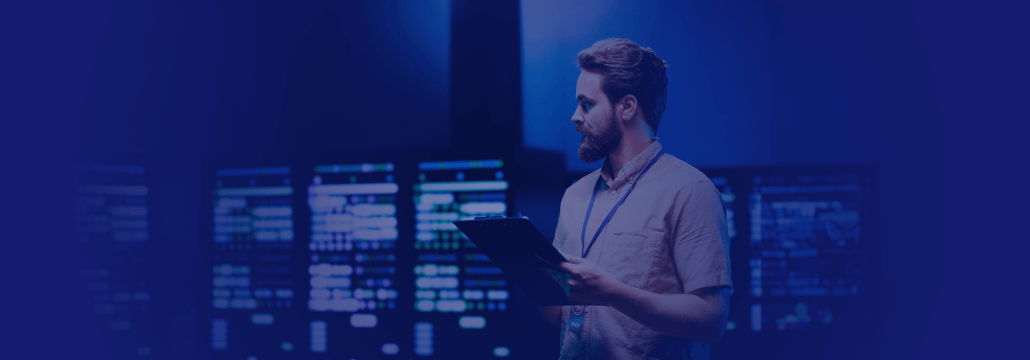Contents:
Businesses of all sizes rely on Windows servers for their simplicity, reliability, and versatility.
However, like endpoints, servers are vulnerable to threats.
Here’s a roundup of the best Windows Server patch management software tools to enhance security and reliability.
What is Windows Server Patch Management Software?
Windows Server Patch Management Software detects, tests, and deploys security patches to keep servers secure and compliant.
It mitigates risks, prevents breaches, and ensures optimal performance, safeguarding data and strengthening cybersecurity.
Windows Server Patch Management Software Benefits
Windows Patch Management Software enhances cybersecurity by systematically updating vulnerable software components.
The four main benefits include.
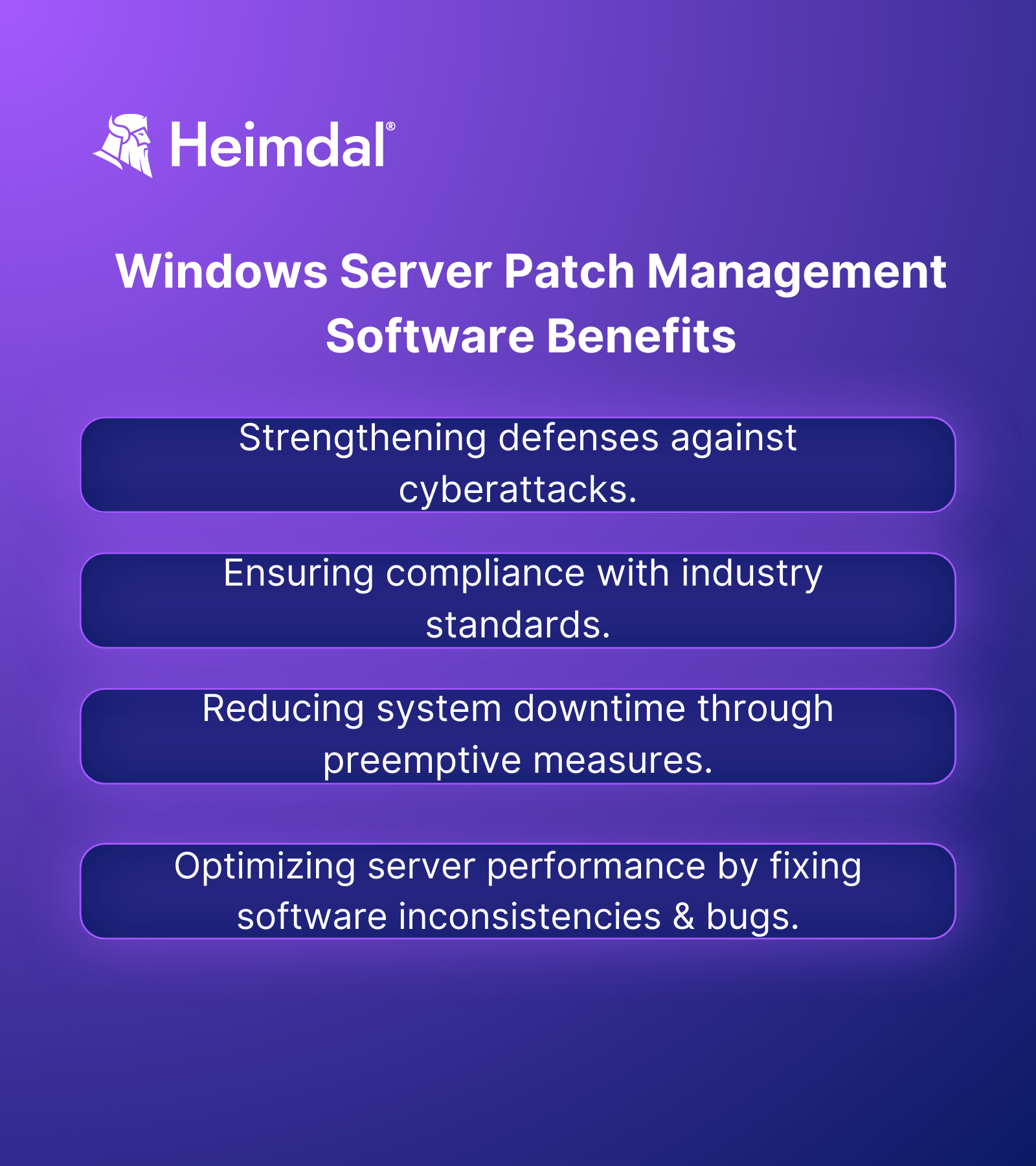
Best Windows Server Patch Management Software in 2026
Let’s deep dive into the list of best windows server patch management software tools.
Heimdal Patch & Asset Management
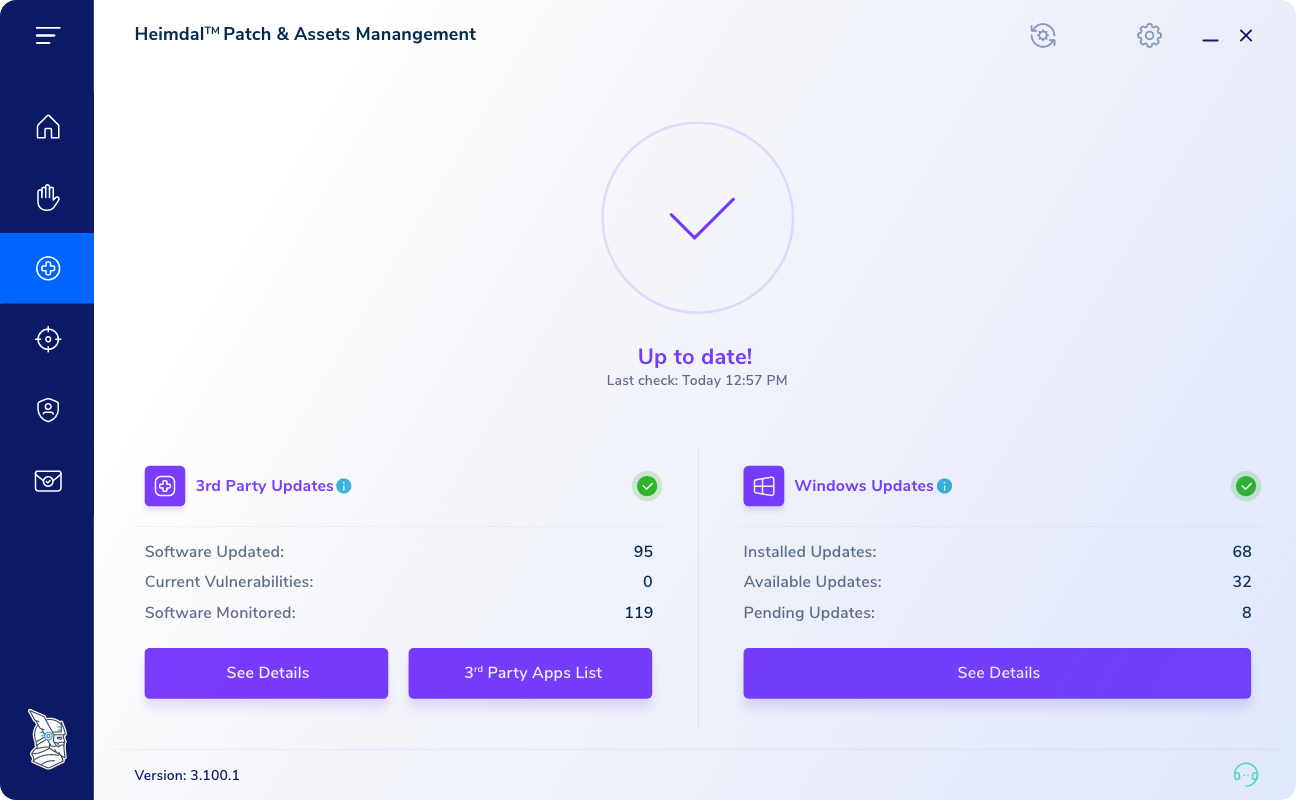
Heimdal’s Patch & Asset Management solution offers a centralized platform for IT professionals to automate and streamline the patching process across diverse platforms, including Microsoft, Apple, and Linux.
This tool ensures continuous compliance, detects missing patches, enacts a patch management program, vulnerability mitigation, and efficient software asset management, enhancing enterprise security posture.
Heimdal Features
- Centralized Console. Simplify patching with a unified dashboard offering visibility and control over software inventory.
- Cross-Platform Support. Unified patching for Microsoft Windows, Apple macOS, Linux Ubuntu, and more.
- Advanced Customization. Tailor patching schedules, prioritize user groups, or let automation decide the best approach.
- 180+ Supported Applications. Out-of-the-box support for third-party applications, ensuring comprehensive coverage.
- Rapid Patch Deployment. Industry-leading vendor-to-end-user waiting time of under 4 hours.
- Policy and Compliance Management. Set and forget settings for automatic software deployment while maintaining compliance.
- Infinity Management Add-On. Enables automation for in-house software or applications using command-line scripting.
- Secure Encryption. Ensures data safety during transit with robust encryption methods.
- Local P2P Patch Distribution. Minimizes bandwidth usage and eliminates the need for client-server models.
- Continuous Compliance. Adherence to industry regulations like GDPR, Cyber Essentials, CIS18, and NIS2.
Heimdal Pros & Cons
PROS:
- Easy to configure.
- Responsive support and aftersales.
- Fast approval and roll-outs across the environment.
- Does not impact system performance..
CONS:
- The dashboard can be intimidating to an inexperienced sysadmin.
Heimdal® Pricing
Our pricing model is regarded as competitive, delivering good value while providing a wide range of security features.
Our solution allows you to consolidate up to seven providers into a single platform while streamlining your IT infrastructure and reducing risk.
- Our prices cover all operating systems (Windows, Mac OS-X, Android).
- We have several different price ranges for seat counts (from 1 up to 20.000+) and servers (from 1 up to 100+).
- The licensing cost varies depending on the subscription period (monthly pricing/ yearly pricing/ 3-year pricing/5-year pricing).
Testimonials
Heimdal Patch and Asset Management provides us with a number of tools. Firstly, we use it to maintain a comprehensive list of software assets installed on all endpoints. Off the back of this, we use the 3rd party software module to keep all supported software up to date with the latest patches.
The final element is ensuring our operating systems are fully patched to reduce the possibility that any vulnerability is exploited. I love that it gives a holistic view of what we have, its current patch status, and what we need to be aware of.
Use Cases & Considerations
✅ Best for:
✔ Businesses needing automated patch management with threat intelligence integration.
✔ Companies looking for zero-day vulnerability protection.
✔ Organizations wanting cross-platform support (Windows & 3rd party apps).
❌ Not suitable for:
✖ Organizations needing on-premise-only patching.
Datto RMM Patch Management
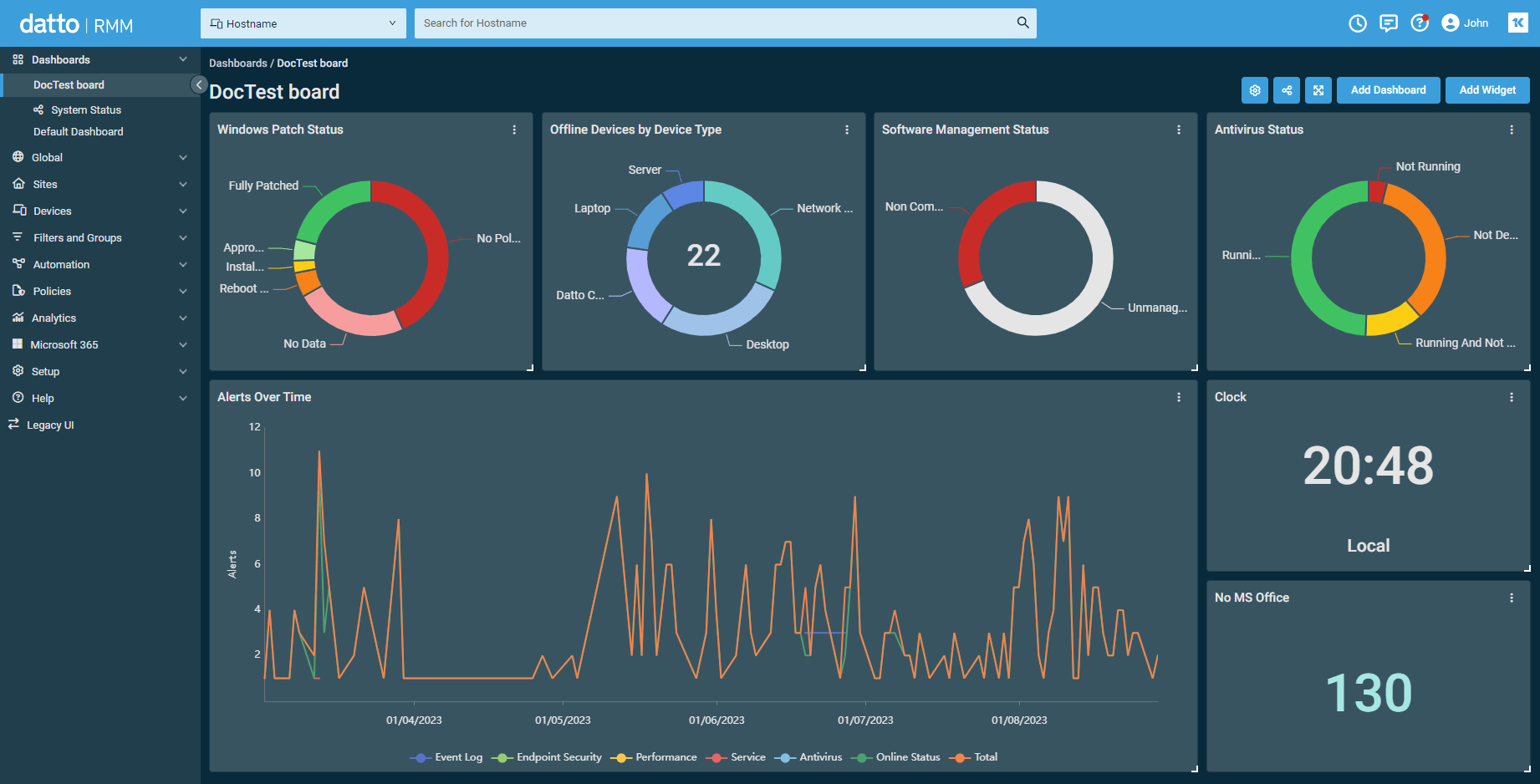
Datto RMM Patch Management is a robust solution designed to control and automate the deployment of patches to Windows devices.
Its main goal is to establish a consistently configured environment that remains secure against known OS vulnerabilities.
The system manages patch deployment based on a device’s patch status, using policies set at both account and site levels.
While it primarily supports Windows-managed agents, there’s also support for macOS devices through a comstore component.
Features
- Consistent Configuration. Ensures a consistently configured environment safeguarded against known vulnerabilities.
- Policy-Based Management. Patch management is governed by policies at both the account and site levels.
- Individual Patch Installations. Allows configurations at the device level for exclusions or tolerances without changing entire policies.
- Microsoft Update Classifications. Provides notes about Microsoft update classifications.
- Windows as a Service Integration. Compatibility with Windows as a Service.
Pros & Cons
PROS:
- Remotely view servers, client systems, and specifications.
- Remotely roll out updates for servers and end-users.
- Connect to user sessions for servers and end-user systems.
CONS:
- Web Remote is generally unresponsive compared to alternative solutions.
- Search result categories are manual.
- Agent client software sometimes doesn’t execute scheduled tasks without notification.
Pricing
Starting at $34.9 per year.
Testimonials
Intermittent Connection Issues: One drawback that users occasionally encounter with Datto RMM is intermittent connection instability. While this issue may not be prevalent for all users, it can disrupt productivity and lead to frustration.
(…) Another limitation of Datto RMM is the unavailability of Slashtop, a remote desktop tool, for Mac users. This restricts the use of certain desktop utilities and diminishes the experience for Mac-based server administrators.
Use Cases & Considerations
✅ Best for:
✔ Managed Service Providers (MSPs) needing centralized remote patching.
✔ Businesses that require automated Windows & third-party app updates.
✔ Companies looking for robust remote monitoring and management (RMM) integration.
❌ Not suitable for:
✖ Enterprises requiring highly granular patch approval workflows.
✖ Organizations needing deep vulnerability scanning (focused mainly on patching).
✖ Businesses looking for a standalone patch management tool (part of Datto RMM).
GOTO RESOLVE
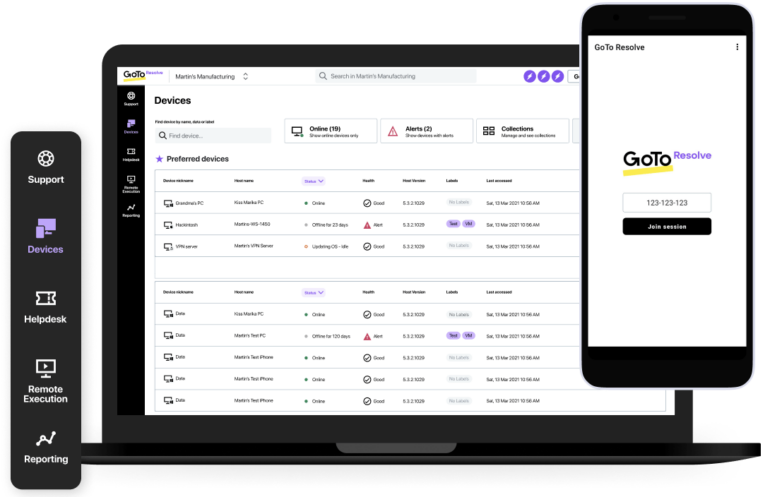
GoTo Resolve is an IT management solution that integrates remote support, RMM, ticketing, and zero-trust architecture.
It offers a unified platform for IT management and support, enabling businesses to proactively monitor, automate, and address IT issues.
Features
- Remote Monitoring and Management (RMM). Offers patch management, customizable alerting, IT automation, antivirus management, and background access.
- No-Code IT Automation. Automate workflows and tasks without scripting knowledge.
- Background Access. Troubleshoot issues without disturbing end-users, access critical system information, and securely transfer files.
- Advanced Security. Features zero-trust access control, 256-bit AES encryption, multifactor authentication, and single sign-on.
- Integrations. Seamless integration with other IT tools and platforms.
Pros & Cons
PROS:
- Remote support.
- Help desk ticketing.
- Endpoint protection.
- Responsive patch management system.
- Quickly identify missing patches.
CONS:
- Limited inventory features.
- Limited Windows patching features.
- Lack of endpoint protection for servers.
GoTo Resolve Pricing
- GoTo Resolve Free – $0 for 3 agents and unlimited endpoints (Cloud only).
- GoTo Resolve MDM – $2.75 per month per endpoint (Cloud only).
- GoTo Resolve Remote support – $40 per month per user (Cloud only).
Testimonials
I like what was described to us as a selling point, ticket system, integrated with Teams, inventory management, ease of use, etc.
(However) It’s a task getting it implemented, we have a free trial account that cannot be deleted so we cannot contact support and open a ticket as it wants us to pay even though we have paid several thousand dollars upfront for the year.
Use Cases & Considerations
✅ Best for
✔ SMBs and IT support teams needing an all-in-one remote management & patching solution.
✔ Businesses looking for simple patch deployment with remote access integration.
✔ Companies that prefer cloud-based solutions with minimal configuration.
❌ Not suitable for
✖ Large enterprises requiring detailed compliance and patch audit reporting.
✖ IT teams needing advanced scheduling & rollback features.
✖ Businesses looking for a highly customizable patching solution.
vRx Patch Management

vRx Patch Management is designed to remediate vulnerabilities across multiple platforms, including Windows, macOS, and Linux while streamlining any type of patch management process.
The lightweight patch management solution is tailored to meet all vulnerability management requirements.
vRX features user-friendly tools and interfaces, ensuring that IT and security teams can deploy updates more efficiently, ensuring a fortified IT infrastructure.
Features
- Automation. Enables updating specific endpoints or applications on a large scale based on specific triggers.
- Patch Cycle Scheduling. Schedule patch deployments during off-hours to avoid service interruptions.
- Server Patch Management. Keeps servers and virtual machines updated without causing traffic congestion.
- CVE Reports. Provides detailed reports on threats, rating severity based on unique system contexts.
- Events and Activities Log. Tracks all events and actions related to patch management and vulnerability remediation.
Pros & Cons
PROS:
- Automated patching flow and patch triggers.
- Ease of use.
- Intuitive UI.
- Quickly patch Windows apps.
CONS:
- Smaller clients experience performance issues.
- New vulnerability notifications cannot be integrated into other software.
- Manual network scans.
Pricing
- vRx Cloud – $5 per asset per month.
- vRx for Nmap – Free per month.
- vRx Enterprise – Custom; contact company for additional pricing information.
Testimonials
Overall, Topia decreased the IT team’s workload and increased their efficiency. (Pros) Automation of patching and contextual prioritization of vulnerabilities saves a lot of time. It’s easy to deploy security patches when ever needed. (On the other hand it) Can be little overwhelming for first time users.
Use Cases & Considerations
✅ Best for:
✔ Enterprises needing automated asset discovery + patch management.
✔ Organizations looking for ITSM & CMDB integration.
✔ Businesses that require advanced compliance reporting & vulnerability insights.
❌ Not suitable for:
✖ Small businesses with limited IT resources (complex setup).
✖ Companies needing third-party patching for all apps (focuses on OS-level patches).
✖ Organizations looking for a lightweight, budget-friendly solution.
Jamf Pro Patch Management

Jamf Pro’s Patch Management solution offers a comprehensive solution for managing and deploying software patches.
It provides IT administrators with tools to monitor software titles for updates, ensuring that devices within an organization remain secure and up-to-date.
Features
- Patch Sources. Integration with various patch repositories to fetch the latest updates.
- Software Titles Management. Monitor specific software titles for available patches.
- Integration with Other Modules. Seamlessly works with other Jamf Pro modules for a holistic device management experience.
- Compatibility Checks. Ensure that patches are compatible with existing system configurations.
- Compliance Monitoring. Track and ensure that all devices comply with the organization’s patching standards.
Pros & Cons
PROS:
- Flexibility of device management.
- Scoping policies.
- Zero-touch policy.
- Patch management for Windows server update services.
- Policy control.
- Patch management tools.
- Patch Windows apps.
CONS:
- Lack of SSO.
- No LDAP integration.
- Limited management of software updates.
Pricing
Contact the vendor for more information on pricing.
Testimonials
Jamf Pro is well suited to manage iOS and MacOS devices for any medium to large sized organization. New device provisioning and management are its strong points. The product could be improved with better patch management and remote access features, but this is something I know Jamf has been working on implementing.
Use Cases & Considerations
✅ Best for:
✔ Organizations managing Apple devices with some Windows compatibility.
✔ IT teams needing patch deployment with Apple MDM integration.
✔ Businesses requiring automated patching & app version control.
❌ Not suitable for:
✖ Windows-centric IT environments (designed for Apple, limited Windows support).
✖ Companies needing on-premises patching (cloud-based).
✖ Organizations looking for enterprise-wide security patching beyond Apple devices.
Pulseway

Pulseway’s Patch Management solution is an integrated IT management platform designed for real-time monitoring, automation, and security.
With a sophisticated multi-level workflow, it offers a comprehensive solution for IT professionals to ensure systems are consistently updated, secure, and compliant.
Features
- Network Monitoring. Probe-based detection and identification of devices on the network with automatic discovery and diagramming.
- Patch Management. Industry-leading software for installing, uninstalling, and updating software.
- Ransomware Detection. Monitors Windows devices for suspicious file behaviors indicating potential ransomware threats.
- Real-Time Monitoring. Comprehensive monitoring for Windows, Linux, and Mac with real-time metrics like CPU temperature, network usage, and more.
- Automated Tasks. Schedule recurring IT tasks for background execution, eliminating manual intervention.
Pros & Cons
PROS:
- System stats at a glance.
- Remote restart.
- Remote updating of Windows machines.
- Sending notifications to servers.
- Doesn’t impact system performance.
CONS:
- Lack of network mapping.
- Server client experiencing random crashes.
- Limited support for the remote desktop application.
- No file transfer option.
Pricing
Enterprise plan – $0.8 per month per installation (Cloud only).
Testimonials
Pulseway’s ease of setup beats other high end competitors. We were able to get a monitoring dashboard created for all of our servers within a matter of hours and not days that it took to do the same with similar competitor products. The web dashboard makes it easy to set up. Not much in terms of network monitoring though.
Use Cases & Considerations
✅ Best for:
✔ SMBs and IT professionals needing an RMM + Patch Management tool.
✔ IT admins who prefer mobile device control & alerts.
✔ Companies looking for cost-effective, easy-to-use patching.
❌ Not suitable for:
✖ Enterprises requiring detailed compliance reports & governance.
✖ Businesses needing full third-party application patching.
✖ IT teams requiring on-premises patching (cloud-based).
Patch My PC
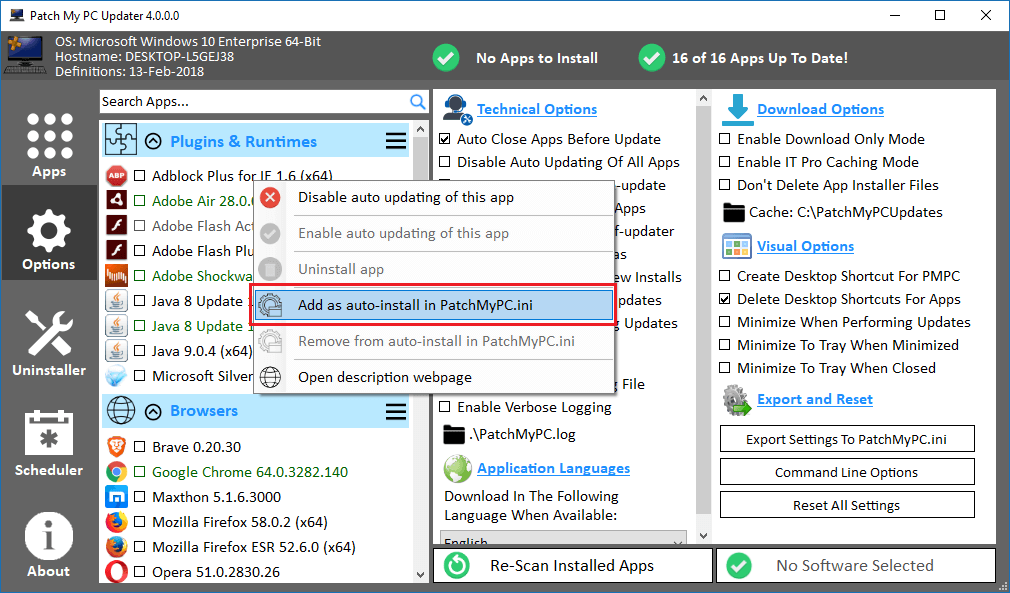
Patch My PC provides an integrated solution for third-party patch management tailored for Microsoft ConfigMgr and Intune.
This platform automates the deployment of software updates, ensuring that enterprise endpoints remain secure and compliant while streamlining the IT management process.
Features
- Comprehensive Support. Integration with Microsoft ConfigMgr and Intune for seamless patch management.
- Application Management. Automatically create application packages for initial deployment.
- Automatic Application Creation. Extend patching capabilities to auto-create applications for initial product deployment in Microsoft SCCM and Intune.
- Auto-Update Applications. Ensures base installs remain current, eliminating the need for post-install updates.
- Customizable Deployments. Run custom pre/post-update scripts for environment-specific configurations.
- Disable Self-Updates. Manage when and how updates are applied by disabling the self-update feature within applications.
Pros & Cons
PROS:
- Easy setup.
- Seamless integration between PCMP publisher and the System Center Configuration Manager (SCCM).
- Extensive online documentation.
- Complete set of patch management tools.
CONS:
- No remote management for server features.
- Outdated UI.
- No feature to customize the app catalog.
Pricing
- Basic – $1 per year per seat (On-premise).
- Enterprise – $2 per year per seat (On-premise).
- Intune essentials – $3.25 per year per seat (On-premise).
Testimonials
We purchased Patch My PC to provide a better way to handle patching of 3rd party apps – that’s essentially what it does. It has saved us many hours of setting up app updates manually and improved our security compliance as there are fewer apps that now need manual intervention to update.
Uses Cases & Considerations
✅ Best for:
✔ SMBs & IT teams needing third-party application patching.
✔ Organizations using Microsoft Intune or SCCM.
✔ Companies looking for a cost-effective, lightweight solution.
❌ Not suitable for:
✖ Enterprises needing centralized Windows OS patching (third-party patching focus).
✖ IT teams requiring detailed vulnerability management.
✖ Businesses looking for advanced automation and custom scheduling.
SecPod SanerNow
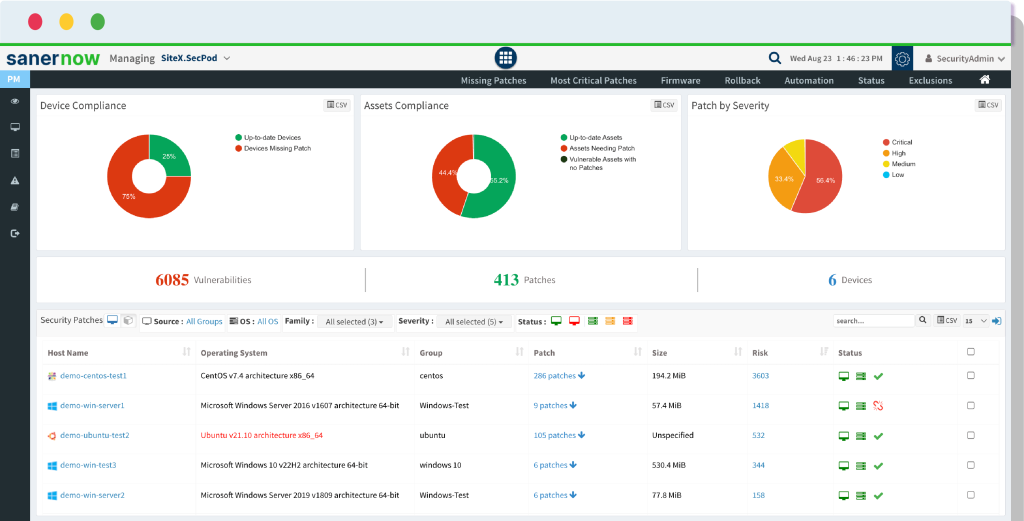
SecPod SanerNow’s Patch Management platform is designed for comprehensive patching across Windows, Mac, Linux, and over 450 third-party applications.
This patch management tool streamlines the patching process, from scanning and prioritization to deployment, ensuring rapid response to vulnerabilities and bolstering enterprise cybersecurity.
Features
- Continuous Patch Scans. Moves beyond periodic scanning to continuous, real-time patch scanning.
- Patch Testing. Allows patches to be tested in a controlled environment before deployment, minimizing disruptions.
- Perimeter-Less Patching. Ideal for hybrid workforces, enabling patch deployment across globally distributed devices.
- Patch Prioritization. Assesses and prioritizes patches based on severity, ensuring critical patches receive immediate attention.
- Firmware Patching. Supports patching for firmware updates, enhancing IT security.
Pros & Cons
PROS:
- Increased visibility over endpoints.
- Powerful reporting features.
- Doesn’t impact system performance.
CONS:
- No EDR.
- Can’t customize the dashboard or the admin control board.
Pricing
Contact the vendor for pricing information.
Testimonials
A great endpoint security & management platform
Pros: >Easy to set up. >Easy to gain visibility about your endpoint security. >Easy to deploy updates to endpoints >A good dashboard that provides visibility across your environment >Doesn’t take up a lot of resources/time 🙂 Cons: Would like to see End point threat detection and response.
Use Cases & Considerations
✅ Best for:
✔ Enterprises needing vulnerability & compliance patching.
✔ IT teams looking for automated risk-based patching.
✔ Businesses wanting real-time vulnerability assessments with patching.
❌ Not suitable for:
✖ Small businesses needing a simple patching tool.
✖ Companies requiring standalone patching (bundled with security tools).
✖ IT admins looking for pure RMM-style patching (more security-focused).
BigFix

BigFix Patch Management for Windows is an advanced cybersecurity solution designed to streamline and automate the patching process across diverse Windows environments.
It emphasizes real-time vulnerability assessment, ensuring systems remain compliant and resilient against emerging threats.
Features
- Real-time Vulnerability. Assessment: Instantly identifies system vulnerabilities.
- Automated Patch Deployment. Reduces manual intervention and human error.
- Comprehensive Reporting. Offers detailed insights into patch status and compliance.
- Customizable Patch Policies. Tailor patching strategies to specific organizational needs.
- Scalability. Efficiently manages large-scale deployments.
Pros & Cons
PROS:
- Secure remote access via VPN.
- Security integration and policy.
- Windows management.
CONS:
- No endpoint analytics.
- Limited automation.
- High latency in agent-to-server communication.
Pricing
Contact vendor for pricing options.
Testimonials
We have significantly enhanced our ability to patch desktops, including laptops, desktop, cloud, virtual machines and other mobile devices used by end-users.
BigFix’s endpoint management functionality allows us to seamlessly patch a wide range of operating systems, such as Windows, MacOS, ChromeOS, and Linux systems, ensuring comprehensive patch management across IT infrastructures.
Use Cases & Considerations
✅ Best for:
✔ Enterprises with hybrid (cloud & on-premise) IT environments.
✔ Organizations needing full OS & third-party patch management.
✔ Businesses looking for detailed compliance, audit logs & rollback options.
❌ Not suitable for:
✖ Small IT teams (high learning curve & costly).
✖ Companies needing pure cloud-based patching (offers hybrid, not SaaS).
✖ Businesses looking for a lightweight or budget-friendly solution.
Automox

Automox offers a cloud-based IT operations solution designed to automate patch management, configuration, and control across Windows, macOS, and Linux endpoints.
Leveraging AI-powered automation, it ensures endpoints are continuously patched, up-to-date, and secure, enhancing cybersecurity and operational efficiency.
Features
- Automated Patch Management. Continuous patching for OS and third-party applications, reducing cyber-attack risks.
- Worklets™Catalog. Access to 320 ready-made Worklets for diverse configurations.
- Automated Policy Enforcement. Prevent configuration drift with automated task enforcement.
- Flexible Device Targeting. Target endpoints by attributes like hostname, IP, OS, and custom tags.
- Global Reach. Patch and configure any software, on any endpoint, anywhere in the world.
Pros & Cons
PROS:
- Integration with Rapid7 offers vulnerability assessment.
- Grouping of servers based on naming conventions.
- Silent installation.
- Endpoint management.
CONS:
- No app repository.
- Lack of integration with security tools.
Pricing
- Basic – $3 per month per endpoint (Cloud only).
- Standard – $ 5 per month per endpoint (Cloud only).
- Complete – $7 per month per endpoint (Cloud only).
Testimonials
Best suited for Linux and Windows Patch management, less appropriate on vulnerability assessment.
Use Cases & Considerations
✅ Best for:
✔ Cloud-first organizations needing automated patch management.
✔ IT teams looking for multi-OS patching (Windows, macOS, Linux).
✔ Businesses that want agent-based patching without VPN dependencies.
❌ Not suitable for:
✖ Organizations needing full SCCM or WSUS integration.
✖ Companies preferring on-premises-only patching.
✖ Businesses requiring granular compliance reports and deep vulnerability scanning.
PDQ Deploy
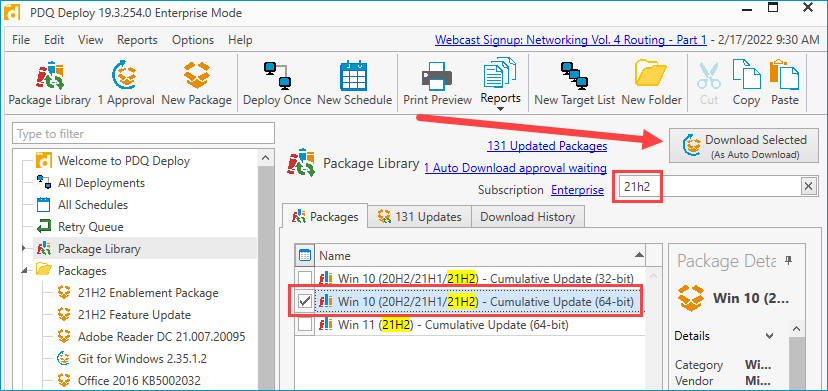
PDQ Deploy is a robust automation tool designed for efficient patch management, endpoint management, and software deployment.
It facilitates the seamless updating of third-party software, execution of custom scripts, and configuration changes, all from a centralized platform, enhancing IT operational efficiency and cybersecurity.
Features
- Package Library. Over 100 popular, ready-to-deploy applications.
- Versatile Deployment. Beyond Windows patching, deploy scripts, files, messages, and more.
- Remote Execution. Script commands in preferred languages like PowerShell, Visual Basic, and Batch.
- Integration. Works seamlessly with PDQ Inventory for enhanced functionality.
- Retry Mechanism. Queue failed deployments for automatic retry.
- Active Directory Integration. Deploy using Active Directory, Spiceworks, and PDQ Inventory.
Pros & Cons
PROS:
- PC hardware and software inventory.
- Custom file monitoring features.
- WMI scanning.
- Vulnerability management.
- Quickly deploy patches.
- Patch status dashboard.
- Patch identification.
CONS:
- Outdated UI.
- Unresponsive interface.
- Automatic client updates on a central server update.
Pricing
- One admin – $500 per year (Cloud only).
- Five admins – $2,500 per year (Cloud only).
Testimonials
PDQ Inventory is great if you have a local network of computers on or off a domain. As long as you have a way to log into them with common credentials. Great for large organizations, particularly ones interconnected with VPNs.
PDQ Inventory isn’t so great for PCs that aren’t connected to the same LAN the server is on. (i.e. non-VPN remote users) They used to have a remote agent you could install, but it was removed after numerous issues.
Use Cases & Considerations
✅ Best for:
✔ Small & mid-sized IT teams needing quick Windows OS & app patching.
✔ IT admins wanting simple, script-based patch deployment.
✔ Companies with on-premises environments looking for fast, manual patching.
❌ Not suitable for:
✖ Enterprises needing automated vulnerability-based patching.
✖ Businesses looking for real-time patch compliance tracking.
✖ Organizations requiring cloud-based patch management.
Dragon RMM (ITarian/Comodo ONE)
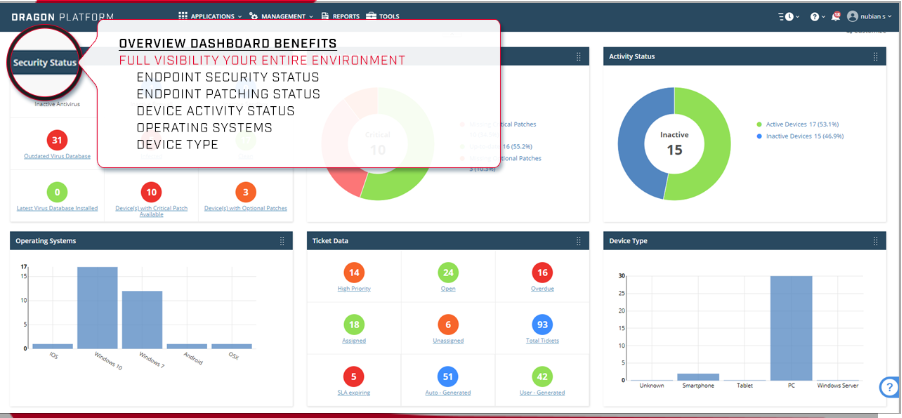
The Dragon RMM solution, integrated within Endpoint Manager, offers a centralized platform to manage OS updates and 3rd party application patches for devices running the Windows Operating System.
It emphasizes automated patch deployment, rollback capabilities, and compliance, ensuring a secure and up-to-date infrastructure.
Features
- Automated Deployment. Procedures for automatic installation of new patches.
- Patch Approval. Auto-approval system with the option to decline specific patches.
- Detailed Patch Information. Classification, severity, release date, and knowledgebase links for each patch.
- Multi-Device Patching. Install or uninstall patches on multiple devices simultaneously.
- Group-Based Patch Viewing. View patches specific to device groups or entire organizations.
Pros & Cons
PROS:
- Remote CMD/PowerShell.
- Custom file monitoring features.
- Sandboxing.
- Integrated EDR software.
- Patch management reports.
- Remote monitoring.
CONS:
- Lacks scripting features.
- Lacks remote control features.
Pricing
Contact the vendor for pricing details.
Testimonials
It is well suited for a startup MSP that cannot afford some of the more expensive tools.
Use Cases & Considerations
✅ Best for:
✔ MSPs & IT professionals needing a free RMM with patching.
✔ Small businesses looking for basic Windows patching & remote monitoring.
✔ Organizations wanting integrated cybersecurity & patching.
❌ Not suitable for:
✖ Enterprises needing full compliance reports & patch history logs.
✖ Companies looking for a standalone patching tool (bundled with RMM).
✖ IT teams needing advanced scheduling & automation features.
Windows Server Patch Management Software Comparison Table
This comparison table highlights the best use cases and limitations of leading solutions, helping you find the right fit for your needs.
| 1. Heimdal® Patch & Asset Management | |||||
| 2. Datto RMM Patch Management | |||||
| 3. GOTO RESOLVE | |||||
| 4. vRx Patch Management | |||||
| 5. Jamf Pro Patch Management | |||||
| 6. Pulseway | |||||
| 7. Patch My PC | |||||
| 8. SecPod SanerNow | |||||
| 9. BigFix | |||||
| 10. Automox | |||||
| 11. PDQ Deploy | |||||
| 12. Dragon RMM (ITarian/Comodo ONE) |
Conclusion
Ensuring that the servers are consistently updated is paramount in cybersecurity.
Regular updates not only enhance performance and stability but also fortify defenses against evolving threats.
Failing to maintain these updates can lead to severe security breaches.
Neglecting this critical task exposes systems to vulnerabilities, compromising data integrity and jeopardizing organizational security. Proactive patch management is a non-negotiable aspect of a robust cybersecurity strategy.
Frequently Asked Questions (FAQ)
What is server patch management?
It’s the systematic process of identifying, acquiring, installing, and verifying updates (or patches) for server environments to address vulnerabilities and improve performance.
Why is patch management crucial for businesses?
It ensures cybersecurity, maintains server health, assures compliance with industry standards, and reduces the risk of costly downtime.
How frequently are patches released?
Patch release schedules vary. Microsoft releases security patches monthly on “Patch Tuesday,” but critical patches can be released as needed.
Can patch management solutions automate the update process?
Yes, many solutions offer automation features to schedule and deploy patches, minimizing manual intervention.
What are the risks of not applying patches promptly?
Delaying missing patches exposes systems to vulnerabilities, increasing the risk of cyberattacks, data breaches, and non-compliance penalties.
How do these solutions prioritize patches?
Most tools categorize patches based on severity, urgency, and impact, enabling organizations to address the most critical vulnerabilities first.
Is there a risk of a patch causing system issues?
Occasionally, patches may cause compatibility or performance issues. Testing patches in a controlled environment before broad deployment is recommended.
How do patch management tools integrate with existing IT infrastructures?
Many tools offer integration capabilities with common IT management platforms, ensuring seamless update processes and centralized control.
Do these solutions support third-party applications?
While primarily designed for servers, many solutions also support patching of third-party applications, broadening the scope of protection.
What’s the difference between a patch and an update?
Generally, a patch addresses security vulnerabilities, while an update can include non-security fixes, new features, or improvements.










 Network Security
Network Security
 Vulnerability Management
Vulnerability Management
 Privileged Access Management
Privileged Access Management  Endpoint Security
Endpoint Security
 Threat Hunting
Threat Hunting
 Unified Endpoint Management
Unified Endpoint Management
 Email & Collaboration Security
Email & Collaboration Security


